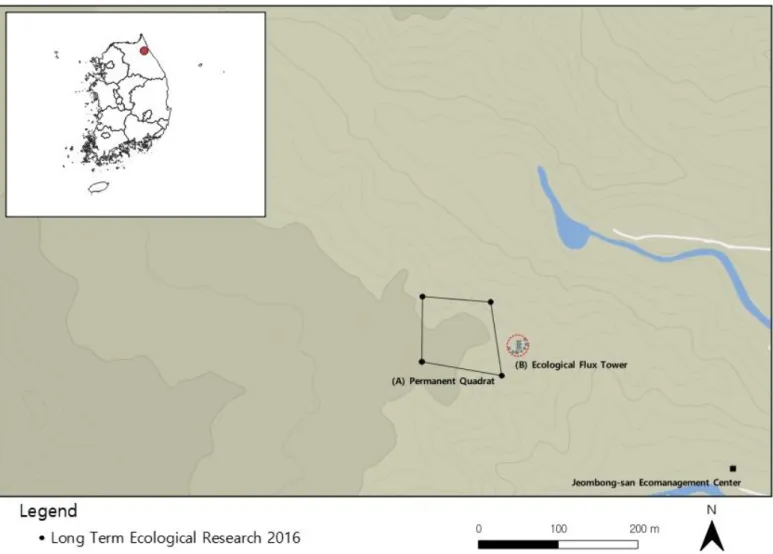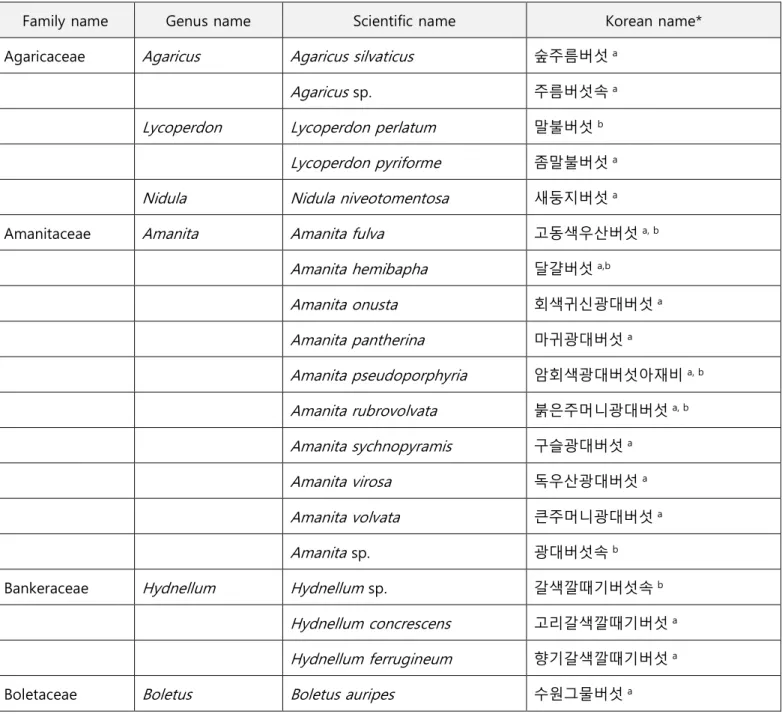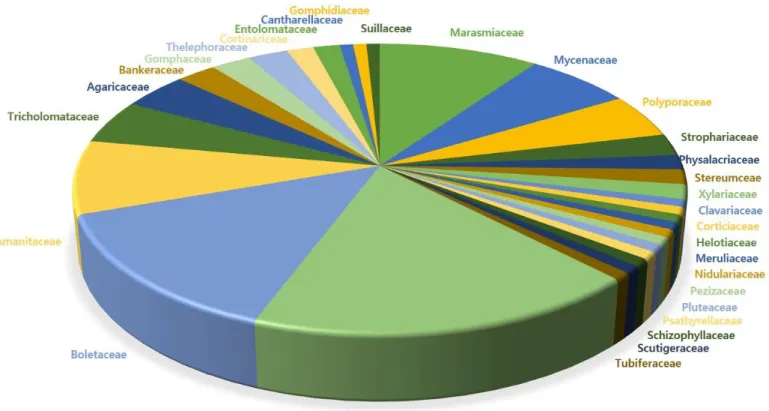DOI https://dx.doi.org/10.22761/DJ2021.3.2.001
[Ecology] Article
The Funga of Higher Fungi of the Mongolian Oak Forest in Mt. Jeombong, Korea
Ju-Kyeong Eo
1* · Eunsu Park
1· Ho-Yeon Won
1· Young Sang Lee
1· Dongsu Yu
2· Areum Han
1· Hwa-Yong Lee
3· Hee-Su Lee
3Division of Climate and Ecology, Bureau of Conservation & Assessment Research, National Institute of Ecology, Seocheon 33657, Republic of Korea
1National Agrobiodiversity Center, National Institute of Agricultural Sciences, Wanju 55365, Republic of Korea
2Department of Forest Science, Chungbuk National University, Cheongju 28644, Republic of Korea
3Received: 9 April 2021 revised: 8 June 2021, accepted: 28 May 2021
Abstract This study was conducted to find the biodiversity of higher fungi at the supersite of Mt. Jeombong from July to October 2016 during the Second Long Term Ecology Research project. A total of 31 families, 52 genera, and 120 species of higher fungi were found within the permanent 1 ha qaudrat and in a 10 m radius of the ecological flux tower. From a taxonomical and ecological perspcetive, Russulaceae (22 species, 18.0%), Boletaceae (17 species, 13.9%), and Amanitaceae (10 species, 8.2%) were the top 3 taxa with the most species found in mycorrhizal mushrooms. Marasmiaceae (10 species, 9.8%), Mycenaceae (8 species, 6.6%), and Polyporaceae (6 species, 4.9%) were also the top 3 taxa with the most species found in saprophytic mushrooms.
Keywords: Funga, Higher fungi, Mongolian oak, Mt. Jeombong, Korea
1. Introduction
The Ministry of Environment of the Republic of Korea conducted the First Long Term Ecological Research (LTER) project from 2004 to 2013 to monitor ecosystem change, maintenance, and conservation. Beginning in 2014, the second LTER project was launched by the National Institute of Ecology. The purpose of the LTER project was to lay the foundation for monitoring of biodiversity and researching the interactions between organisms from a supersite on Mt. Jeombong in Gangwon-do. For this, a roadmap of the 2nd LTER project established in 2014, and the supersite was established in the experimental forest of Mt. Jeombong in 2015. In 2016, research on the interactions between organisms was conducted at the supersite. All synthetic studies conducted at this supersite divided into one of eight topics:
(1) population dynamics and wetland, (2) plant community and nutrient cycling, (3) insect–plant correlation, (4) soil microbial biodiversity and its environment, (5) forest bird community and feeding guild structure, (6) forest bat community, (7) forest food network structure, and (8) ecology and environment space database construction. As part of this effort, we collected diversity data on higher fungi in the Mongolian oak (
Quercus mongolica
Fisch. ex Ledeb.) forest of Mt. Jeombong in 2016 (National Institute of Ecology, 2016).2. Project description
Title: Soil microbial biodiversity and its environment
In 2016, we conducted a study on soil microbial biodiversity and its environment at the supersite of Mt. Jeombong.
The aim of the research was to investigate the community of soil microorganisms in a forest ecosystem and to understand the interactions between microorganisms. However, unlike other microorganisms, higher fungi form fruiting bodies that can be observed directly with the naked eye. Therefore, we focused our investigation on higher fungi through the collection and analysis of diversity data.
3. Methods
Our research was conducted within the permanent quadrat measuring 100 × 100 m (1 ㏊) and in a 10 m radius of the ecological flux tower on Mt. Jeombong. We checked the host plants and surrounding environment and observed characteristics, like the color and shape of the fruiting bodies. The identification of higher fungi was performed by combining macroscopic and microscopic characteristics, such as the cap, stem, and spores. In addition, the “Wild Fungi of Korea” (Park and Lee, 2010) and “Nihon no kinoko” (Imazeki, 2011) were referenced for the identification and classification of higher fungi. These data were produced in accordance with the data standards and quality control procedures of the EcoBank ecological database of the National Institute of Ecology.
4. Temporal coverage
The biodiversity data on higher fungi in this study were produced during the 2nd LTER from July to October 2016.
5. Spatial coverage
This research was conducted within the permanent 1 ha quadrat defined by the following geographic coordinates:
upper left: N 38° 02′18.90″ E 128° 28′00.96″, upper right: N 38° 02′18.65″ E 128° 28′04.46″, lower left: N 38° 02′16.25″
E 128° 28′00.89″, and lower right: N 38° 02′15.65″ E 128° 28′04.99″ and in a 10 m radius of the ecological flux tower (center: N 38° 02′16.87″ E 128° 28′05.94″) on Mt. Jeombong in Inje-gun, Gangwon-do, Korea (Fig. 1).
Figure 1. Map of the research site at Mt. Jeombong in Gangwon-do (shown as a red circle in the inset). Biodiversity of higher fungi conducted within (A) the permanent 1 ha quadrat (100 × 100 m) indicated by black lines and (B) in a 10 m radius (red dotted circle) of the ecological flux tower.
6. Results
A total of 31 families, 52 genera, and 120 species were identified (Table 1). Among them, mycorrhizal mushrooms were found in 13 families, 23 genera, and 76 species. There were 2 genera and 22 species in Russulaceae, 6 genera and 17 species in Boletaceae, 1 genus and 10 species in Amanitaceae, 3 genera and 6 species in Tricholomataceae, and 3 genera and 5 species in Agaricaceae. One genus and three species were identified in Bankeraceae,
Gomphaceae, and Thelephoraceae, whereas one genus and two species were found in Cortinariceae and Entolomataceae. One genus and one species were identified in Cantharellaceae, Gomphidiaceae, and Suillaceae.
Saprophytic mushrooms were found in 18 families, 29 genera, and 44 species. There were 5 genera and 10 species in Marasmiaceae, 2 genera and 8 species in Mycenaceae, 3 genera and 6 species in Polyporaceae, and 2 genera and 3 species in Strophariaceae. Two genera and two species were identified in Physalacriaceae, Stereumceae, and Xylariaceae. Futher, one genus and one species were identified in Clavariaceae, Corticiaceae, Helotiaceae, Meruliaceae, Nidulariaceae, Pezizaceae, Pluteaceae, Psathyrellaceae, Schizophyllaceae, Scutigeraceae, and Tubiferaceae (Fig. 2). The results of this research were published as part of the 2nd LTER Report (National Institue of Ecology, 2016).
Table 1. List of higher fungal species collected from the Mongolian oak forest of Mt. Jeombong.
Family name Genus name Scientific name Korean name*
Agaricaceae
Agaricus Agaricus silvaticus
숲주름버섯aAgaricus
sp. 주름버섯속aLycoperdon Lycoperdon perlatum
말불버섯bLycoperdon pyriforme
좀말불버섯aNidula Nidula niveotomentosa
새둥지버섯aAmanitaceae
Amanita Amanita fulva
고동색우산버섯a, bAmanita hemibapha
달걀버섯a,bAmanita onusta
회색귀신광대버섯aAmanita pantherina
마귀광대버섯aAmanita pseudoporphyria
암회색광대버섯아재비a, bAmanita rubrovolvata
붉은주머니광대버섯a, bAmanita sychnopyramis
구슬광대버섯aAmanita virosa
독우산광대버섯aAmanita volvata
큰주머니광대버섯aAmanita
sp. 광대버섯속bBankeraceae
Hydnellum Hydnellum
sp. 갈색깔때기버섯속bHydnellum concrescens
고리갈색깔때기버섯aHydnellum ferrugineum
향기갈색깔때기버섯aBoletaceae
Boletus Boletus auripes
수원그물버섯aBoletus erythropus
붉은대그물버섯aBoletus ornatipes
밤색갓그물버섯aBoletus sensibilis
붉은줄기그물버섯aBoletus
sp. 그물버섯속a, bBoletus subtomentosus
산그물버섯aLeccinum Leccinum aurantiacum
껄껄이그물버섯a, bLeccinum extremiorientale
접시껄껄이그물버섯aLeccinum scabrum
거친껄껄이그물버섯bLeccinum
sp. 껄껄이그물버섯속bPhylloporus Phylloporus
sp. 민그물버섯속aPulveroboletus Pulveroboletus ravenelii
노랑분말그물버섯a, bTylopilus Tylopilus alkalixanthus
녹슨쓴맛그물버섯a, bTylopilus neofelleus
제주쓴맛그물버섯a, bTylopilus
sp. 쓴맛그물버섯속bXerocomus Xerocomus chrysenteron
마른산그물버섯aXerocomus subtomentosus
산그물버섯a CantharellaceaeCantharellus Cantharellus minor
애기꾀꼬리버섯a ClavariaceaeRamariopsis Ramariopsis kunzei
쇠뜨기버섯a CorticiaceaeCorticium Corticium chrysocreas
황금고약버섯a CortinariceaeCortinarius Cortinarius purpurascens
풍선끈적버섯aCortinarius traganus
연자색끈적버섯a, bEntolomataceae
Entoloma Entoloma rhodopolium
삿갓외대버섯a, bEntoloma
sp. 외대버섯속aGomphaceae
Ramaria Ramaria botrytis
싸리버섯a, bRamaria flava
노랑싸리버섯bRamaria formosa
붉은싸리버섯aGomphidiaceae
Chroogomphus Chroogomphus vinicolor
비단못버섯a HelotiaceaeChlorociboria Chlorociboria aeruginosa
녹청균bMarasmiaceae
Gymnopus Gymnopus confluens
밀꽃애기버섯a, bGymnopus dryophilus
굽은꽃애기버섯a, bGymnopus peronata
하얀색 가랑잎애기버섯a, bGymnopus peronatus
가랑잎꽃애기버섯aGymnopus
sp. 꽃애기버섯속a, bMarasmius Marasmius maximus
큰낙엽버섯bMarasmius siccus
애기낙엽버섯bMarasmiellus Marasmiellus
sp. 선녀버섯속bRhodocollybia Rhodocollybia butyracea
버터철쭉버섯aXeromphalina Xeromphalina campanella
이끼살이버섯bMeruliaceae
Radulodon Radulodon copelandii
긴송곳버섯bMycenaceae
Mycena Mycena amygdalina
가마애주름버섯a, bMycena crocata
노란애주름버섯aMycena galericulata
콩나물애주름버섯aMycena haematopus
적갈색애주름버섯aMycena rorida
점질애주름버섯aMycena pura
맑은애주름버섯aMycena
sp. 애주름버섯속bPanellus Panellus stipticus
부채버섯a, bNidulariaceae
Crucibulum Crucibulum laeve
찻잔버섯aPezizaceae
Peziza Peziza
sp. 주발버섯속aPhysalacriaceae
Cylindrobasidium Cylindrobasidium evolvens
담자고약버섯bArmillaria Armillaria mellea
뽕나무버섯a, bPluteaceae
Pluteus Pluteus atricapillus
난버섯a, bPolyporaceae
Polyporus Polyporus badius
검정대구멍장이버섯aPolyporus varius
노란대구멍장이버섯aMicroporus Microporus vernicipes
메꽃버섯부치aTrametes Trametes hirsuta
흰구름송편버섯aTrametes versicolor
구름송편버섯bTrametes
sp. 송편버섯속aPsathyrellaceae
Psathyrella Psathyrella candolleana
족제비눈물버섯a RussulaceaeLactarius Lactarius chrysorrheus
노란젖버섯a,bLactarius flavidulus
누룩젖버섯aLactarius hygrophoroides
흰주름젖버섯bLactarius piperatus
굴털이a,bLactarius scrobiculatus
민들레젖버섯a, bLactarius subplinthogalus
얇은갓젖버섯aLactarius subzonarius
당귀젖버섯aLactarius volemus
배젖버섯a, bLactarius
sp. 젖버섯속aRussula Russula alboaxeolata
흰꽃무당버섯aRussula amoena
가지무당버섯aRussula cyanoxantha
청머루무당버섯a, bRussula emetica
무당버섯a, bRussula japonica
갈변흰무당버섯aRussula mariae
수원무당버섯a, bRussula nigricans
절구무당버섯a, bRussula omiensis
보라무당버섯aRussula rosea
졸각무당버섯aRussula sanguinea
혈색무당버섯a, bRussula senecis
흙무당버섯a, bRussula virescens
기와버섯aRussula
sp. 무당버섯속aSchizophyllaceae
Schizophyllum Schizophyllum commune
치마버섯a ScutigeraceaeAlbatrellus Albatrellus confluens
다발방패버섯aStereumceae
Stereum Stereum ostrea
갈색꽃구름버섯a, bXylobolus Xylobolus spectabilis
너털거북꽃구름버섯a, bStrophariaceae
Hypholoma Hypholoma fasciculare
노란개암버섯aHypholoma sublateritium
개암버섯a, bGymnopilus Gymnopilus liquiritiae
미치광이버섯aSuillaceae
Suillus Suillus luteus
비단그물버섯aThelephoraceae
Thelephora Thelephora palmata
단풍사마귀버섯bThelephora penicillata
붓털사마귀버섯aThelephora
sp. 사마귀버섯속bTricholomataceae
Lepista Lepista sordida
자주방망이버섯아재비aLepista nuda
민자주방망이버섯aLepista
sp. 자주방망이버섯속aOudemansiella Oudemansiella radicata
민긴뿌리버섯aClitocybe Clitocybe truncicola
황색깔때기버섯aClitocybe
sp. 깔때기버섯속aTubiferaceae
Lycogala Lycogala epidendrum
분홍콩점균bXylariaceae
Hypoxylon Hypoxylon truncatum
검은팥버섯aDaldinia Daldinia concentrica
콩버섯aa, permanent quadrat; b, ecological flux tower
*, Korean name of mushroom is referred to “National Species List of Korea”, “Wild Fungi of Korea”.
Figure 2. Taxonomical structure of families of higher fungi of Mt. Jeombong, Korea. Russulaceae (22 species, 18.0%), Boletaceae (17 species, 13.9%), and Amanitaceae (10 species, 8.2%) are the top 3 taxa with the most species found in mycorrhizal mushrooms. Marasmiaceae (10 species, 9.8%), Mycenaceae (8 species, 6.6%), and Polyporaceae (6 species, 4.9%) are also the top 3 taxa with the most species found in saprophytic mushrooms.
7. Acknowledgements
This work was supported by a grant from the National Institute of Ecology (NIE), funded by the Ministry of Environment (MOE) of the Republic of Korea (NIE-B-2016-02).
8. Usage rights
Use license: Other
IP rights notes: Creative Commons CC-BY 4.0
9. Data resources
Number of dataset: 1
Data set name: higherfungi1.zip Data format: *.shp, *.xlsx
*.shp files: Map of research site of higher fungi of Mt. Jeombong Higherfungi.xlsx: Raw data of higher fungi of Mt. Jeombong.
http://doi.or.kr/10.22756/GEO.20210000000757
10. References
Imazeki R (2011) Nihon no kinoko. Yamatokeikokusha, Tokyo
National Institute of Biological Resources (2019) National Species List of Korea Ⅰ Plants, Fungi, Algae, Prokaryotes.
National Institute of Biological Resources, Incheon
National Institute of Ecology (2016) Project of Long Term Ecological Research. National Institute of Ecology, Seocheon
Park WH, Lee HD (2010) Wild Fungi of Korea. Kyo-Hak Publishing, Seoul
11. Metadata
Sort Field Subcategory#1 Subcategory#2 Description Note
Essential
Title The funga of higher fungi of Mt.
Jeombong Dataset1 LTER
(2016):
The funga of higher fungi of Mt.
Jeombong
*DOI name 10.22756/GEO.20210000000757 - -
*Category biota macrofungi
Abstract
*Temporal
Coverage July to October 2016 Acquisition period
*Spatial Coverage
• Permanent quadrat
- Upper left: N 38° 02′18.90″ E 128° 28′00.96″
- Upper right: N 38° 02′18.65″ E 128° 28′04.46″
- Lower left: N 38° 02′16.25″ E 128° 28′00.89″
Point World Geodetic System (WGS84)
- Lower right: N 38° 02′15.65″ E 128° 28′04.99″
• Ecological flux tower
- Center: N 38° 02′16.87″ E 128°
28′05.94″
*Personnel
Registrant (Ju-Kyeong Eo)/
Owner (National Institute of Ecology)
Name Ju-Kyeong Eo
Affiliate National Institute of Ecology
e-mail abiesendo@gmail.com
*License Open data Open data Open data
Optional
*Project Soil microbial biodiversity and
its environment LTER (2016)
Instrument


